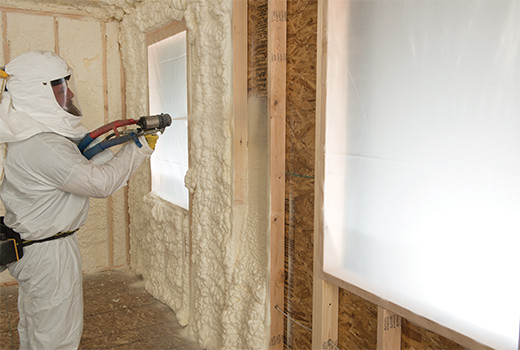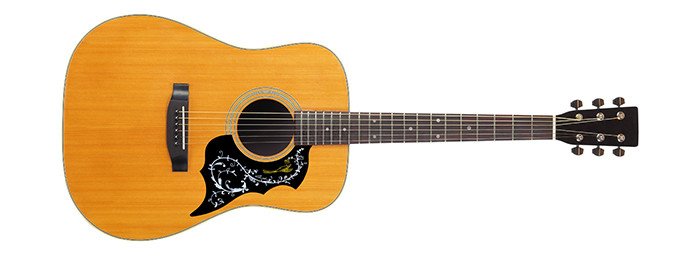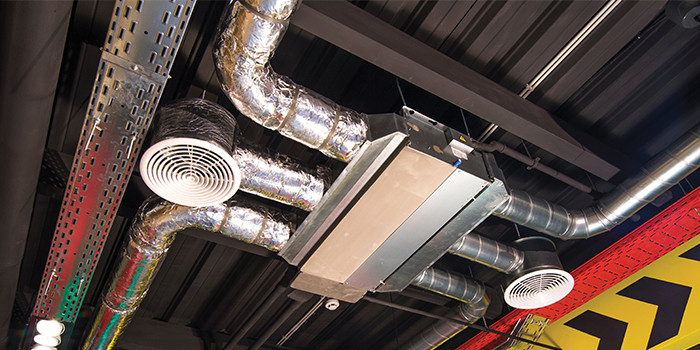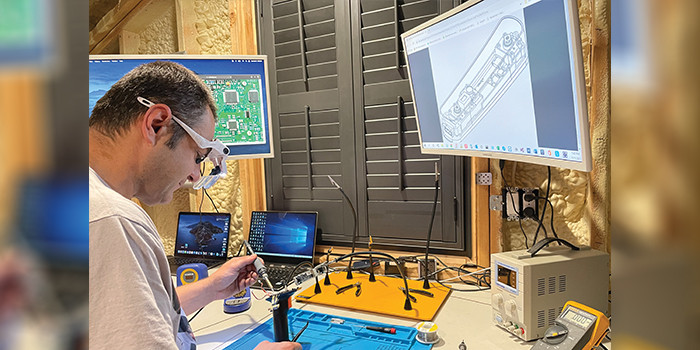
Sound & Space

Spray Foam Magazine – Fall Issue 2021 – Acoustics are an important consideration when designing any kind of space. However, they are even more important to keep in mind for certain types of projects, such as healthcare facilities, multi-family homes, and schools. Spaces designed for music and other types of performance will have specific acoustic requirements. With increasing numbers of people working from home, home offices also require more consideration.
Noisy spaces can negatively impact occupants, especially in learning environments where it might be difficult to hear or concentrate. A quiet environment can boost productivity, ease tension, improve concentration, and foster creativity. Occupant comfort, privacy, and speech intelligibility are the main reasons why it’s important to keep acoustics in mind when designing a space.
Factors That Affect Acoustics
The acoustics of a space are determined by multiple factors, including:
The size of the space. Sounds have more room to bounce around in a larger space. If there are high ceilings or alcoves, this problem can be intensified.
How well the walls of the space are insulated. Adequate insulation in walls helps reduce sound transmission through them. Fibrous insulation, such as fiberglass or mineral wool, converts acoustical energy into mechanical energy. Open-cell spray foam also provides noise-reducing properties. The thicker the insulation, the more sound it will absorb. Thicker materials also address a broader range of frequencies; thicker insulation will capture lower frequencies on the sound spectrum. Bass tones in music, for example, are captured by thicker insulation.

Open-cell spray foam provides noise-reducing properties and acoustic benefits that are on par with fibrous insulations.
The properties of the materials in the space. Softer materials, such as carpets, drapes, and cushions, absorb sounds. Harder materials like wood floors, tile, metal, and polished surfaces reflect sounds. Acoustical paneling or acoustical ceiling tiles are designed to provide noise absorptive properties. The absorption of products across the typical vocal range is represented by the noise reduction coefficient (NRC), which is the average of the absorption coefficients at 250, 500, 1000, and 2000 Hz. If a piece of carpet has an NRC of 0.8, for example, it would absorb approximately 80 percent and only reflect 20 percent of incident sound.
The NRC influences a room’s reverberation time, which is the time it takes for sound to decay after the sound is made. In general, a lower reverberation time is better. The optimal decay time depends on the size of the room as well as its purpose. Classrooms should typically have a reverberation time below .6 to .7 seconds so that reflected sounds don’t interfere with speech intelligibility. On the other hand, spaces intended for music performance are often designed to have a longer reverberation time to allow the sound to build and fill the space.

Spaces intended for music performance are often designed to have a longer reverberation time to allow the sound to build and fill the space.
Different Requirements for Different Wall Systems
Different wall systems require different amounts of acoustic consideration. Better-performing wall systems reduce airborne sound transmission. Extra care is required when designing the following types of wall systems:
Walls between patient rooms in a healthcare facility. The Health Insurance Portability and Accountability Act (HIPAA) requires that healthcare providers take reasonable measures to keep patient information private. These measures include making sure that medical information shared by patients is not overheard. The Facility Guidelines Institute (FGI) provides guidance on acoustic requirements for healthcare facilities based on HIPAA requirements.
Dividing walls between units in a multi-family residential building. The International Builder’s Code specifies acoustic performance standards for walls between units; some cities or counties then modify this code. Building codes typically include minimum requirements for sound transmission and impact attenuation of demising walls and floor/ceiling assemblies. However, owner requirements may provide stricter standards for specific uses or “luxury” accommodations.
Classroom walls. Under the ANSI/ASA S12.60 standard developed by the American National Standards Institute (ANSI) and its predecessor, the American Standards Association (ASA), there are sound guidelines for creating learning spaces with desirable listening conditions because speech intelligibility is paramount. Communication via speech is such an important part of the learning process that background noise and reverberation must be minimized so as not to interfere with learning.
Walls around a home office. While there are no set requirements for home offices, increasing numbers of people working from home means that we need to consider the acoustic performance of the walls in a home office setting. For the benefit of the office occupant as well as the other people in the home, it’s important to minimize sound transmission. »
Walls around amenity or service spaces. It all comes back to occupant comfort. There are numerous spaces in multi-unit buildings, such as pool equipment rooms, trash compactors, HVAC/pump rooms or fitness centers, that are inherently noisy. It’s important to make sure that the noise from these types of spaces doesn’t disturb occupants in other parts of the building.
The Role of Spray Foam in Improving Acoustics
Open-cell spray foam provides acoustic benefits that are on par with fibrous insulations. Although closed-cell spray foam offers fewer acoustics benefits than open-cell spray foam, closed-cell spray foam can provide an air barrier as well as higher R-values, so it can be helpful when an air barrier is needed. Closed-cell spray foam can also be used in a combination with other types of fibrous insulation (in a hybrid system) to improve the acoustic performance of wall systems.
A hybrid solution combines closed-cell spray foam with fiberglass batts and rolls, blow-in fiberglass, or mineral wool insulation. This solution incorporates both the benefits of closed-cell spray foam and fibrous insulation, providing advanced water, air, vapor, thermal and acoustical performance at a better value. It also offers built-in air sealing and vapor control solution that fills all gaps and voids.
Here are a few hybrid uses where spray foam insulation can be used in conjunction with fiberglass batts and rolls, blow-in fiberglass, or mineral wool insulation to improve the acoustic properties of a wall:
To seal around junction boxes. Any time there is an air gap, the acoustic performance of the wall decreases. In fact, performance can drop by up to 5-10 Sound Transmission Class (STC) points if there is a gap along the perimeter of the wall or elsewhere. Ideally, putty pads should be used around electrical boxes to help air seal around them. Spray foam insulation can be used around these spaces as well. Spray foam expands and conforms to the size of the space, which helps ensure these boxes are well sealed and that there are no gaps. Any gap or hole cut in a wall is an acoustic weak link. Spray foam can fill all the nooks and crannies and potentially help protect acoustic integrity.
To close gaps around insulation panels. In the real world, installation isn’t always perfect. If there’s even a small gap between fiberglass insulation, there can be a loss in acoustic performance. To ensure that your insulation meets its expected STC rating, consider adding spray foam as an additional layer. Spray foam can help close gaps in the seams between panels, potentially protecting against loss of acoustic performance if fibrous insulation settles over time.
How Johns Manville Can Help
Johns Manville offers a broad range of insulation products to meet your needs, including fiberglass, blow-in fiberglass, Polyisocyanurate (Polyiso) continuous insulation, mineral wool, and JM Corbond® closed-cell and open-cell spray foams. Learn more about our insulation products here: www.jm.com/building-insulation.
Check out The Source for the latest Insulation Intel® on industry trends, insights, and continuing education opportunities: www.JM.com/the-source-BI.
Jeffrey Job, Sr. Specifier Services Representative & Cat Palmer, Associate Content Manager, Johns Manville














